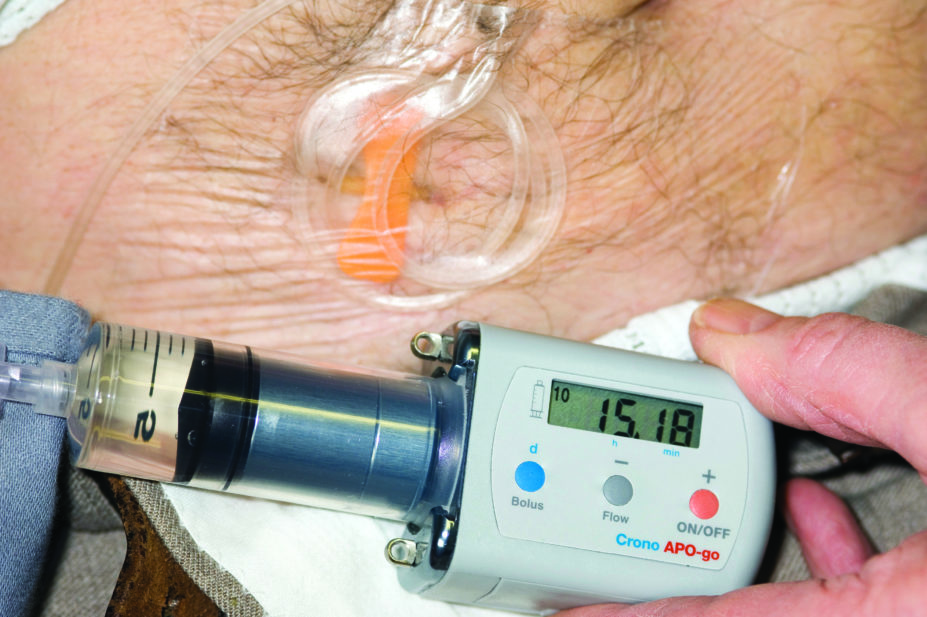
Dr P Marazzi/Science Photo Library
Apomorphine, a drug first used to treat advanced Parkinson’s disease in the United States in the 1950s, has been confirmed as an effective treatment for the disease.
Researchers conducted a prospective, randomised, double-blind, phase III study, due to be presented at the American Academy of Neurology’s 69th annual meeting in Boston, Massachusetts, on 25 April 2017[1]
, and found that subcutaneous apomorphine is effective in reducing “off” time in Parkinson’s disease patients with severe motor fluctuations not controlled by conventional drug therapy. “Off” time describes periods of the day when a patient’s medication is not working well, causing their Parkinson’s symptoms to worsen.
The researchers found that those individuals who were given apomorphine had, on average, 2.5 hours less “off” time per day compared with those given placebo, who experienced only a 30 minute per day reduction in “off” time. This result was observed after one week of treatment and although the study only comprised 107 participants, Andrew Lees, co-author of the study, says the results point to a clear conclusion. The study was supported by Britannia Pharmaceuticals.
“This study has filled a gap in the drugs evidence-based treatment profile and confirmed the potency of a drug which is now 150 years old,” says Lees. “The findings were highly significant so the number of patients is more than adequate to make definite conclusions.”
Apomorphine’s use grew in the 1990s when European doctors began to administer the drug as a subcutaneous infusion. However, evidence on its effectiveness and safety has been lacking.
“Although the drug has for many years been licensed in Europe, Australia and the Far East where it is recognised as a useful rescue treatment, as well as the least invasive way of ensuring continuous tonic stimulation of striatal dopamine receptors, there are still countries where the pump is not reimbursed. As a consequence, many patients continue to be denied what in some situations can be a lifesaving treatment.
“This treatment is much more efficacious than any treatment available for Alzheimer’s disease or multiple sclerosis but because it has no patent it remains underused,” adds Lees.
Janine Barnes, a neurology specialist pharmacist at the Dudley Group NHS Foundation Trust, describes the results of the study as “very interesting”.
“‘Off’ time is a huge problem for Parkinson’s patients and 2.5 hours less off time is a considerable benefit to an immobile patient,” says Barnes.
“I often prescribe apomorphine for Parkinson’s patients when their oral medications are proving less effective at controlling their motor function. We have extensive data from open-label studies with apomorphine that demonstrate its efficacy in reducing ‘off’ time and dyskinesias as well as allowing oral levodopa dose to be reduced in patients with severe motor fluctuations that are poorly controlled by conventional therapy. But evidence from randomised, blinded studies has been lacking and so this will be a very useful piece of research.”
Trials are continuing to determine if alternative routes of administration, such as inhalation, sublingual strips, oral and patch pumps will be as well tolerated and efficacious as subcutaneous apomorphine in the long term.
References
[1] Katzenschlager R, Poewe W, Rascol O et al. Double-blind randomized, placebo-controlled, Phase III study (TOLEDO) to evaluate the efficacy of apomorphine subcutaneous infusion in reducing OFF time in Parkinson’s disease patients with motor fluctuations not well controlled on optimized medical treatment [abstract]. In: American Academy of Neurology 69th Annual Meeting, 2017 Apr 22-28. To be presented at Boston, Massachusetts, 5:45pm ET, Tuesday 25 April 2017.

